Disclaimer: This post contains affiliate links to handpicked partners, including tours, gear and booking sites. If you click through or buy something via one of them, I may receive a small commission. This is at no extra cost to you and allows this site to keep running.
What is Tokyo like? Things to know about Japan’s capital of uniqueness, where the bold merges with tradition and order balances the chaos.
Whilst Japan requires more than one visit to cover its vast grounds, there is no better introduction than jumping headfirst into its huge capital – the buzzing Tokyo metropolis.
The city holds a tremendous amount of fascination and a reputation for uniqueness. Modern boldness merges with tradition and order to create what would be typically chaotic, prompting many to wonder what it is like in Tokyo.
For over a week, Tokyo was home. It was a new and bewildering space, like Scarlett Johansson’s character in ‘Lost in Translation’. It didn’t intimidate or frustrate me; it just made me love it for the things you don’t see elsewhere, its little quirks and bizarre offerings, and for not losing its traditions in light of its rapid, modern growth, where locals are reviving historic spaces amongst the highrise.
So, what does Tokyo look like? How does it function? What is Tokyo known for? What places can give you the best glimpses into Tokyo life?
Here are the reasons why I love Tokyo and what makes it so unique to travel in.

Street view of the Tokyo Skytree Tower.
READ MORE: Japan Travel Budget – Country costs for a multi-week trip.
BOOK: See the best of Tokyo on a full-day sightseeing bus tour.
Contents
- Why is Tokyo so Clean?
- Japanese Etiquette in the City
- Shops Have an Abundance of Everything
- The Pedestrian Walkways are Colossal
- Tokyo is the Best at Themed Cafes
- Where People Have a Unique Fashion Sense
- Architecture is Neat, Compact and Functional
- Mass Advertising on City Buildings
- A Finely Tuned Tokyo Metro
- Transport is On Time
- Plastic Food Previews
- Vending Machines on Every Street Corner
- Japanese People are Always Helpful
- Tradition still Exists in Tokyo City
- Drink in Tokyo’s Tiny Bars
- Dare to Enter Ear-splitting Pachinkos
- There’s a Theme Park in Tokyo’s Centre
- Day Tours in Tokyo
- Guide Books and Further Reading
- Want to Visit Tokyo and See What it’s Like? Pin It!
Why is Tokyo so Clean?
Tokyo is so clean that it almost looks brand new. You’ll rarely see rubbish strewn on the pathways or dropped as litter, and no large bin bags are left festering for collection. The ‘five-second’ rule of eating something dropped on the floor could turn into the ‘five-minute’ practice, and no graffiti covers an old wall or alleyway. Tokyo cleanliness even extends to dedicated smoking areas to contain the littering of cigarettes.
When you visit Tokyo, you’ll get a window into the future where people respect their surroundings.
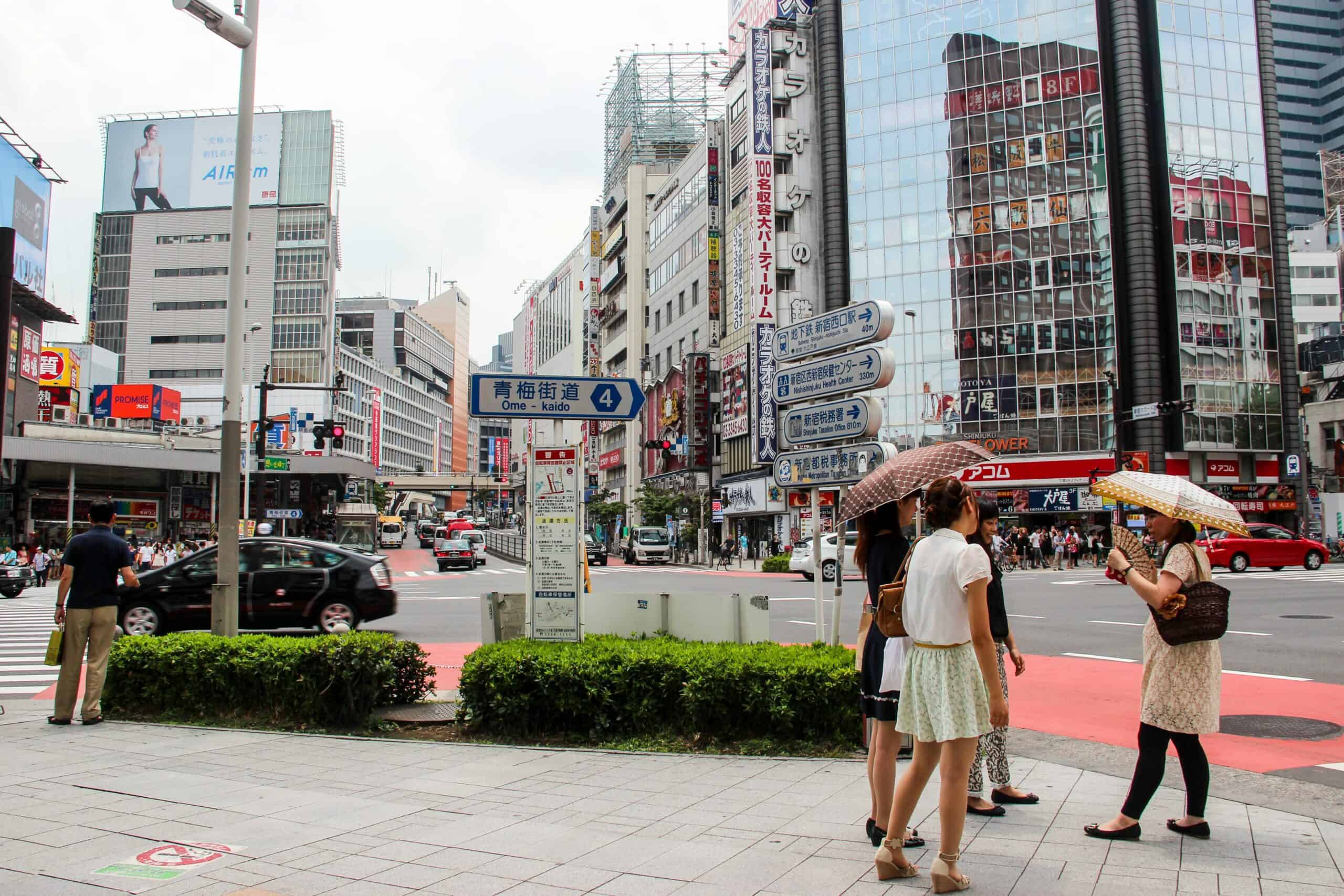
The roads, the pavements – everything is clean in Tokyo.

Tokyo’s cleanliness extends to dedicated cigarette smoking stations.
Japanese Etiquette in the City
The Japanese are polite and welcoming and follow a rigid etiquette that you should try to uphold, too. Unlike most cities where people often become disgruntled, Tokyo hasn’t lost its civility. People here follow the same etiquette: bowing when saying hello and thank you is the norm, as is giving and receiving items and gifts with both hands.
Even when paying, you should place the money in the plastic tray, where the cashier will return your change. Guesthouse owners go out of their way for you, and shop workers are some of the cheeriest people you will meet. This is a beautiful thing to encounter daily in Tokyo and beyond and a reminder of the importance of mutual respect.
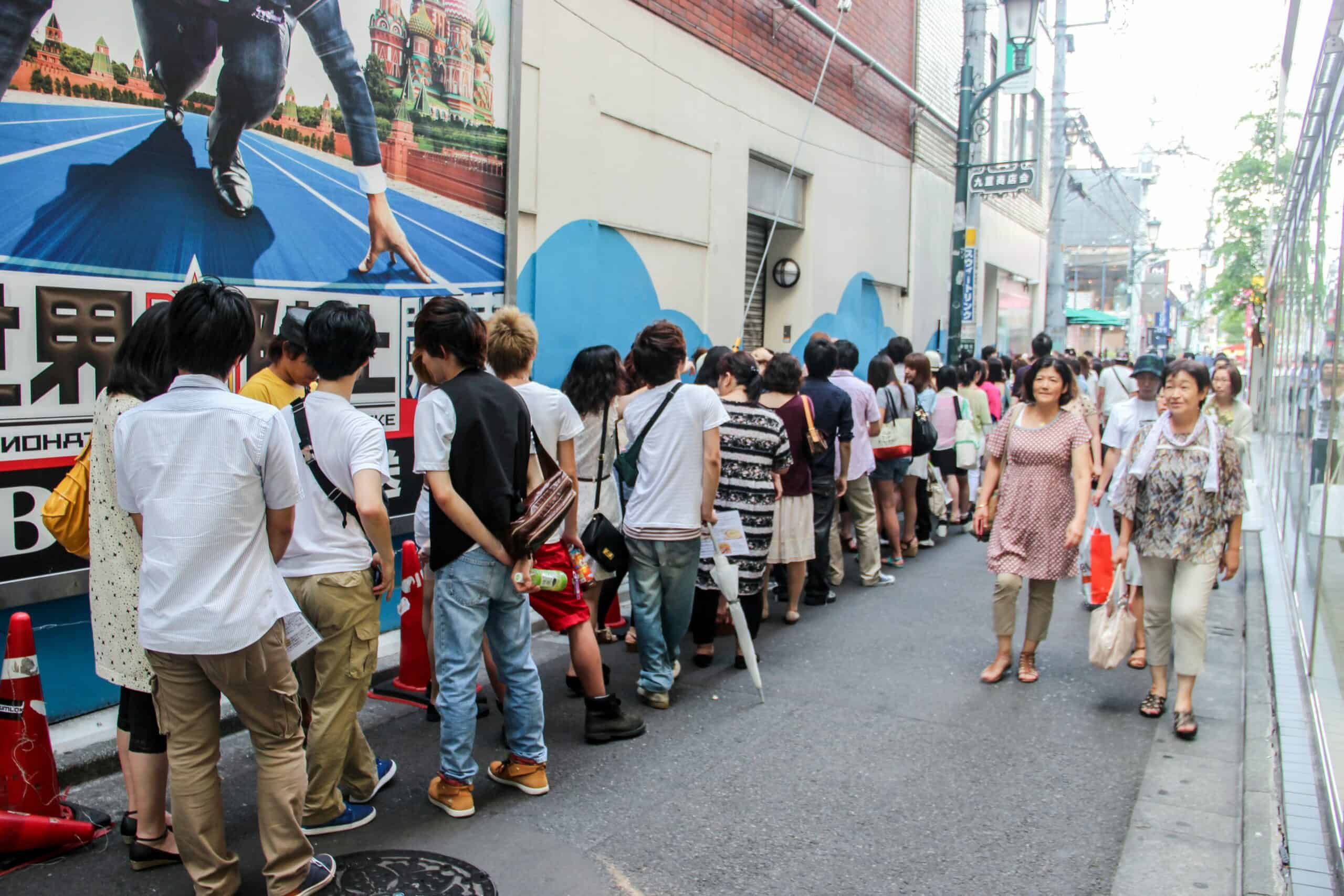
Forming an orderly queue in Tokyo.
Shops Have an Abundance of Everything
Beyond huge shopping malls are convenience stores and little specialist shops that sell household, lifestyle, or beauty goods. Inside you’ll find an overwhelming plethora of products of every variety. It’s fascinating, and making a final choice here must take hours.
The aisles are sometimes decked out in handcrafted neon-coloured signs and posters to point you in the right direction, although it’s still difficult enough to know where to start. No matter how many times I walked past one of these shops, I still went in, even though they all looked the same.
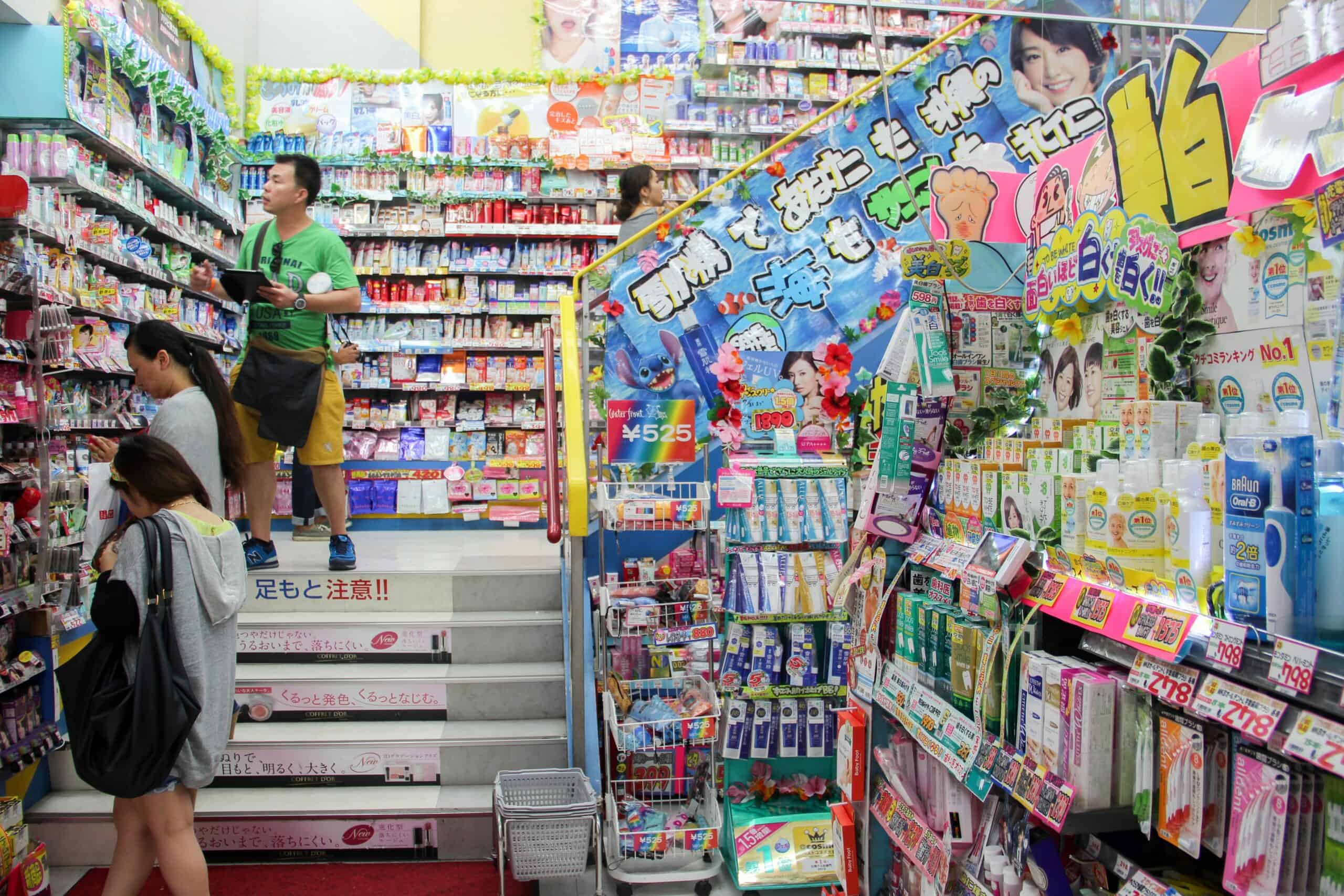
This is what shopping in Tokyo looks like.
The Pedestrian Walkways are Colossal
Tokyo doesn’t just have standard pedestrian walkways; it has enormous pedestrian walkways. Tokyo doesn’t care too much for footbridges and funky walkways a la Hong Kong and Bangkok – it creates an artistic vision of beautiful chaos on its roads only. Take the famous Shibuya Crossing as an example – hundreds of people in Tokyo cross at any one time in a calm and orderly way.
In places like Shinjuku, some uniformed men help ease the people traffic flow on the thick, white lines that line many parts of the many roads out here.
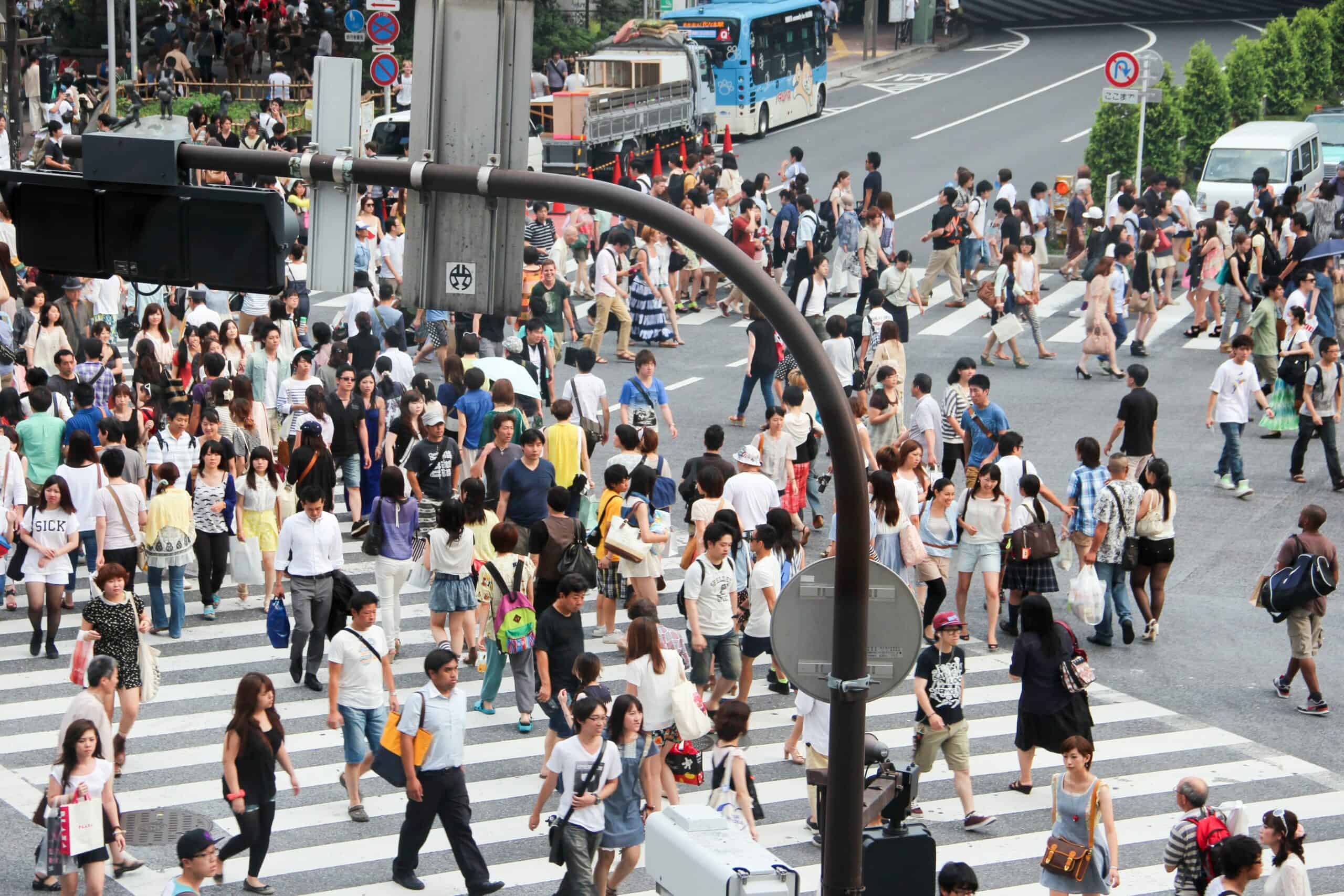
The famous Shibuya Crossing is less chaotic than it appears.
Tokyo is the Best at Themed Cafes
What is Tokyo without its quirks and oddities? It wouldn’t be the same city without them, and one of those is in the form of its many themed restaurants and cafes. There are cat, robot and Super Mario cafes, Vampire, Ninja and Alice in Wonderland restaurants, and many more. I decided to have dinner at the Alcatraz ER restaurant, where you sit behind prison bars and bang on them with a metal rod to call attention to the waiter. My cocktail was made with syringes, and eccentric doctors and nurses served my food.
READ MORE: The Robot Restaurant in Tokyo, Japan – A Futuristic Foodie Experience
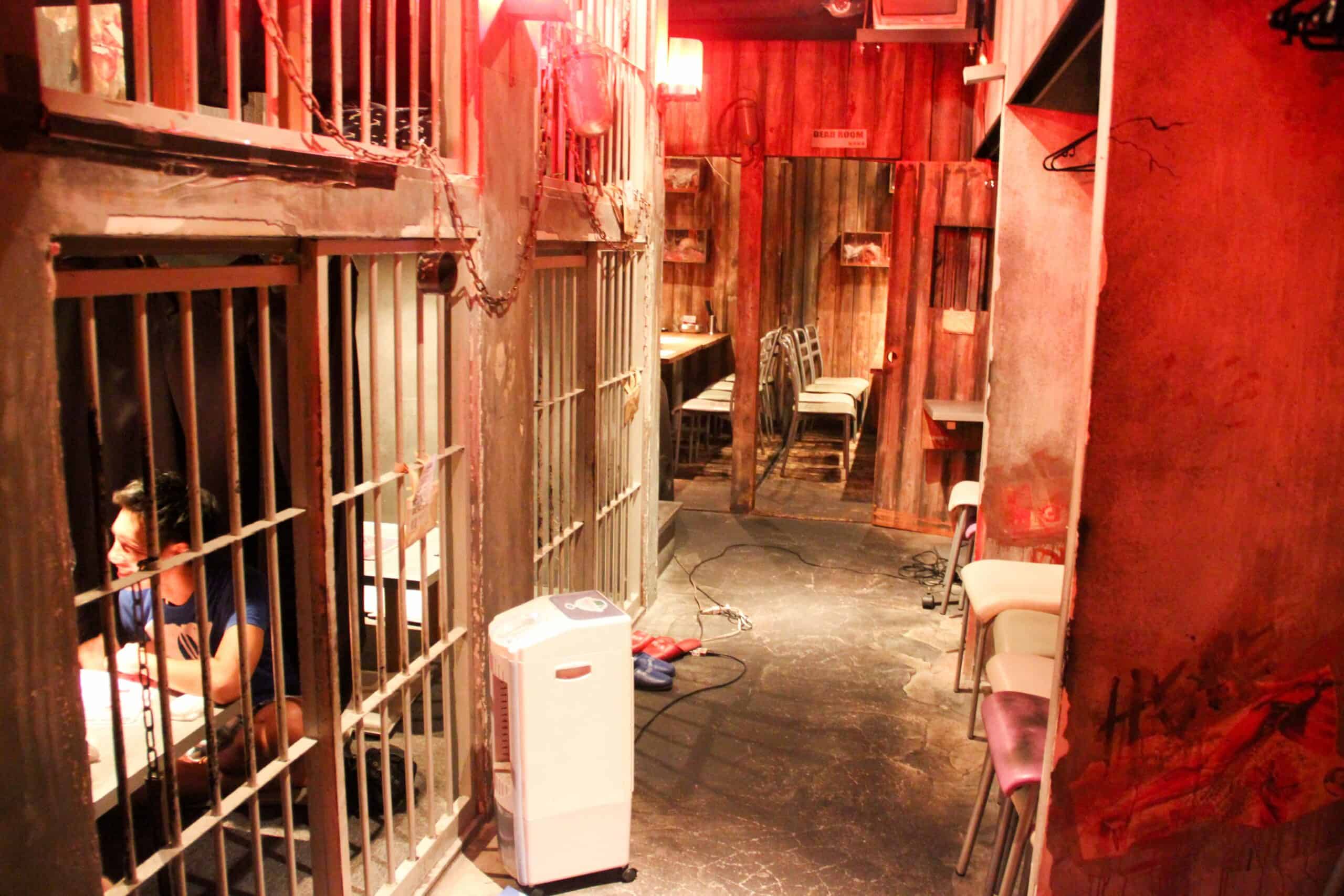
The Alcatraz-themed cafe in Tokyo.
Where People Have a Unique Fashion Sense
Gwen Stefani sang about the “subculture in a kaleidoscope of fashion,” which piqued my curiosity to visit Harajuku. Were these people real? Harajuku has a distinct style, and while you will find all manner of individual fashion styles throughout the city, nothing says unique quite like this city enclave. Sunday is the best day for people-watching.
Little Boo Peeps, Goths and rockers, and best friends who wear the same outfit head to toe. Throw in funky hairstyles, doll makeup and a few traditional yukatas (kimonos), and you would think this is a dress party in a shopping district. Except it isn’t – these young Tokyo locals style with pride, artistry, and confidence.
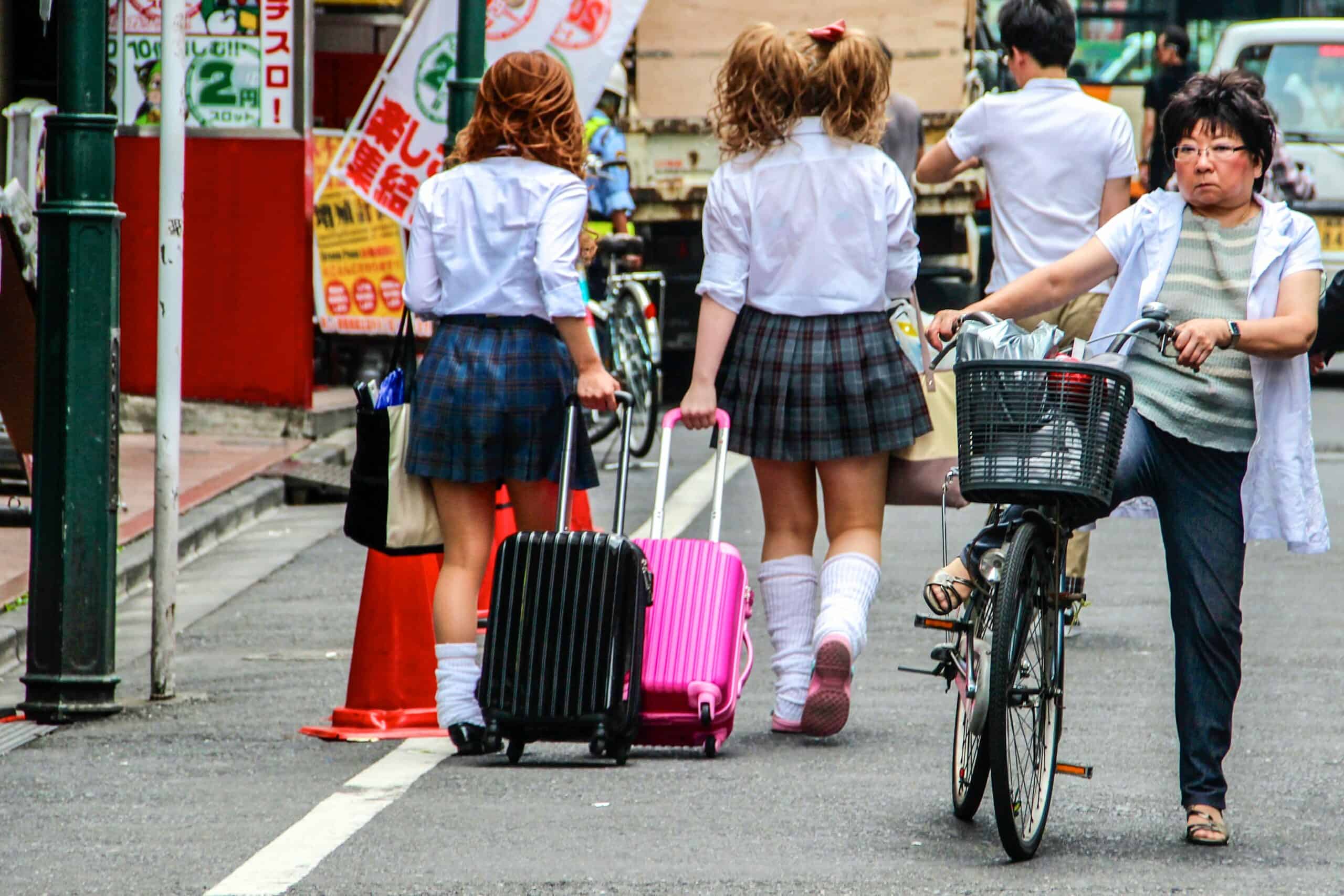
Harajuku is a showcase of Tokyo’s unique fashion.
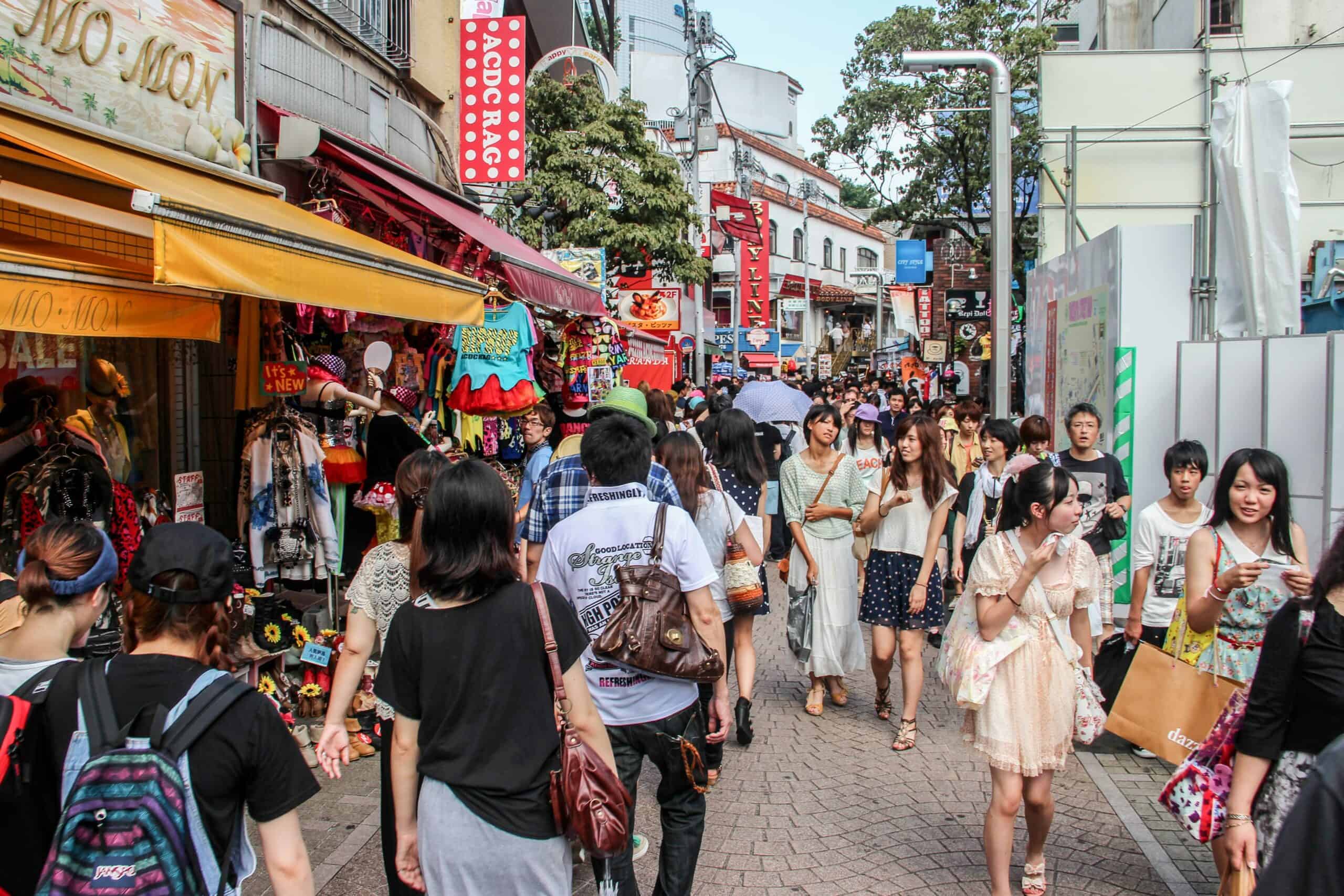
The famed Takeshita Street in Harajuku.
Architecture is Neat, Compact and Functional
I love the architecture in Tokyo, from the grandiose skyscrapers in the centre to the local houses in inner neighbourhoods that are traditionally wood-built or compact modern structures made of brick and metal. In the capital and throughout Japan, most of the residential buildings here are either small and very square or tall and rectangular thin, exist in varying earthy shades of coffee, caramel and grey and neatly placed together.
Although Tokyo has its area of skyscrapers and modern architecture, the overwhelming feeling here is for the design to be functional and straightforward rather than used as a showpiece. Or the emphasis on keeping and reviving old historic structures and family heirlooms.
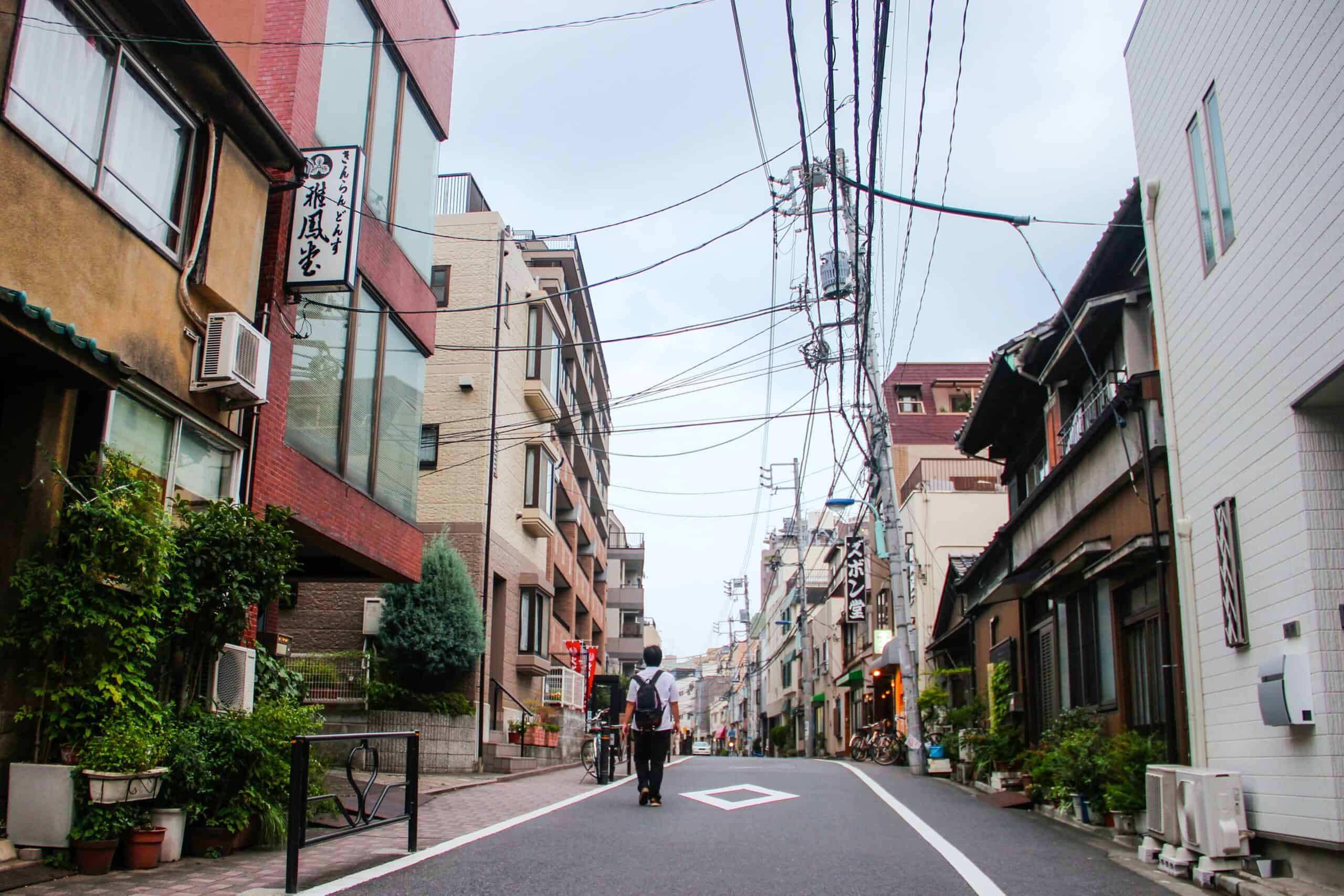
A typical Tokyo neighbourhood outside of the centre.

Traditional Japanese wooden houses.
Mass Advertising on City Buildings
A sign on the front of a shop or other outlet is not enough here. Instead, signs protrude from the sides of buildings, overwhelming you in a sea of choice and Japanese characters. In the areas like Shinjuku, Shibuya and Ginzo, where facilities have more than one floor, there may be as many as six signs denoting the different uses of each floor, including restaurants, bars, cafes and beauty salons. Which means many signs – up, down and all around.
Nothing is more impressive than when night comes in, and all the symbols light up like a psychedelic version of Times Square.
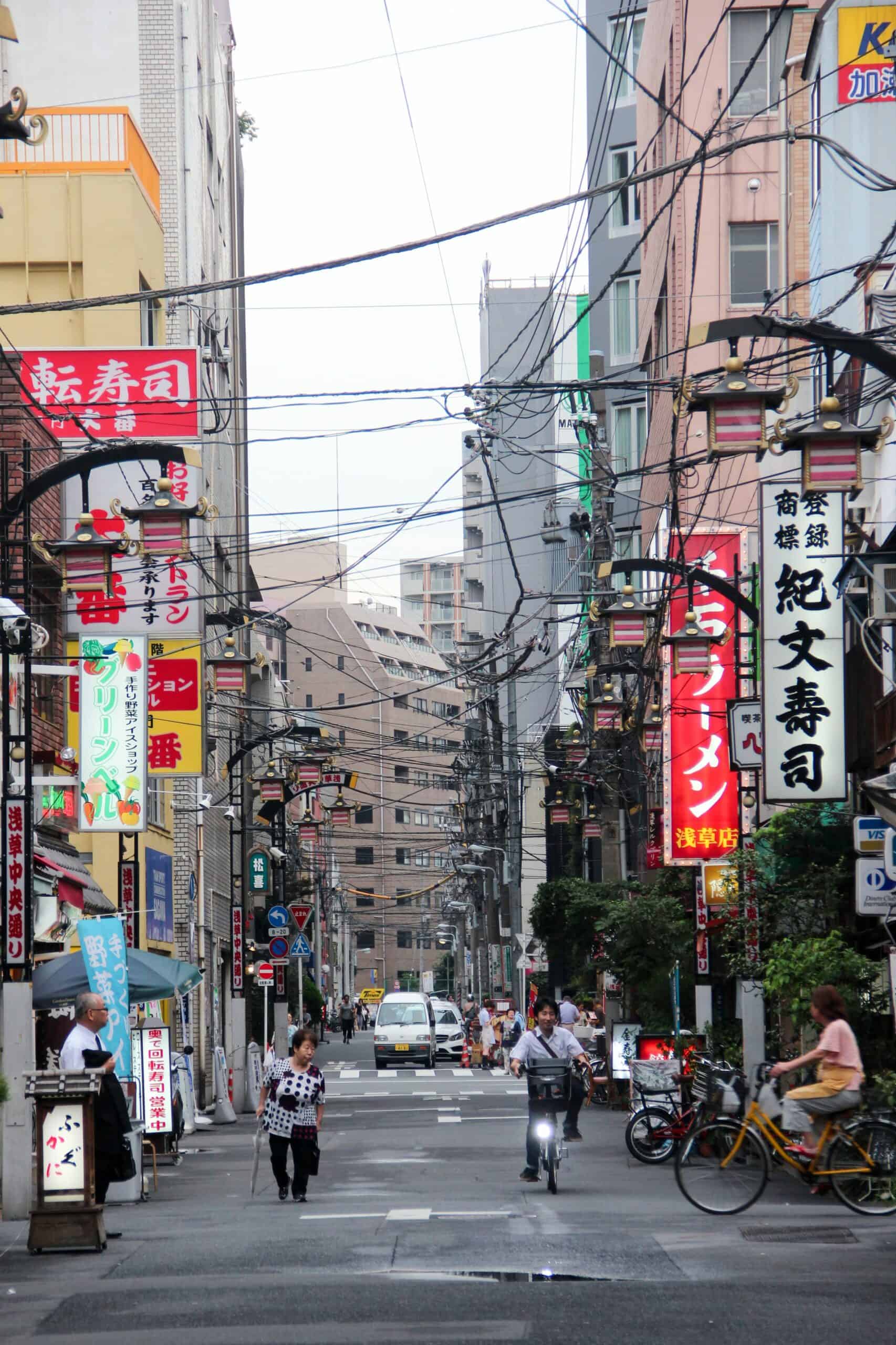
Streets lined with flag signage.
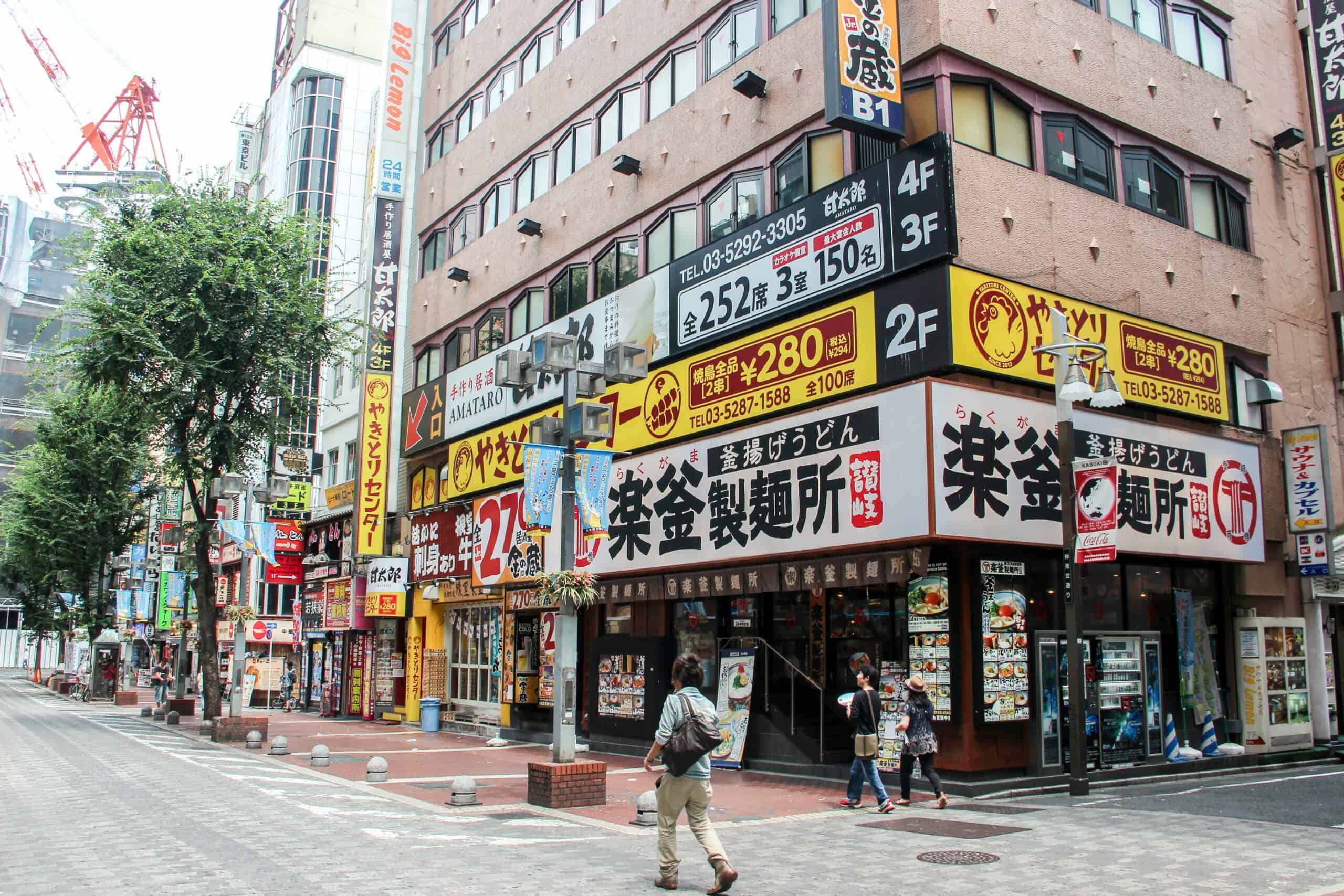
Signage for every building level.
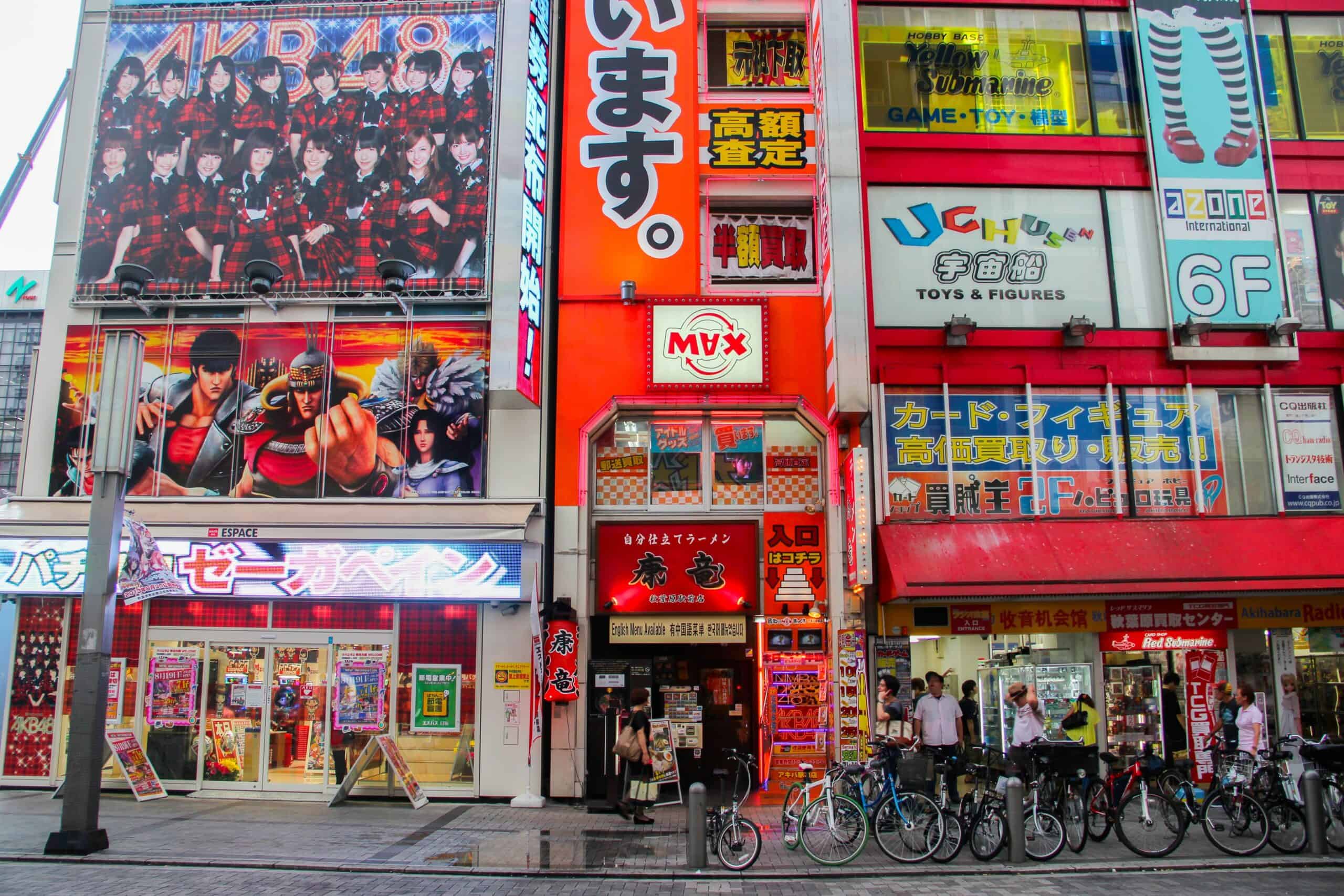
The headspin of Akihabara.
A Finely Tuned Tokyo Metro
I love the metro underground train – in London, Paris, Beijing, Shanghai, and Hong Kong, each has its unique operation. The Tokyo metro is something special. There’s no chaos (outside commuter hours); no one is in a rush or runs and pushes on the trains and escalators. A cute jingle plays when the train stops at every station stop. There are even mirrors on some platforms (although I am unsure about the reason)
The only downside here is the long walks between the lines, but the cheery tune puts a smile back on your face.
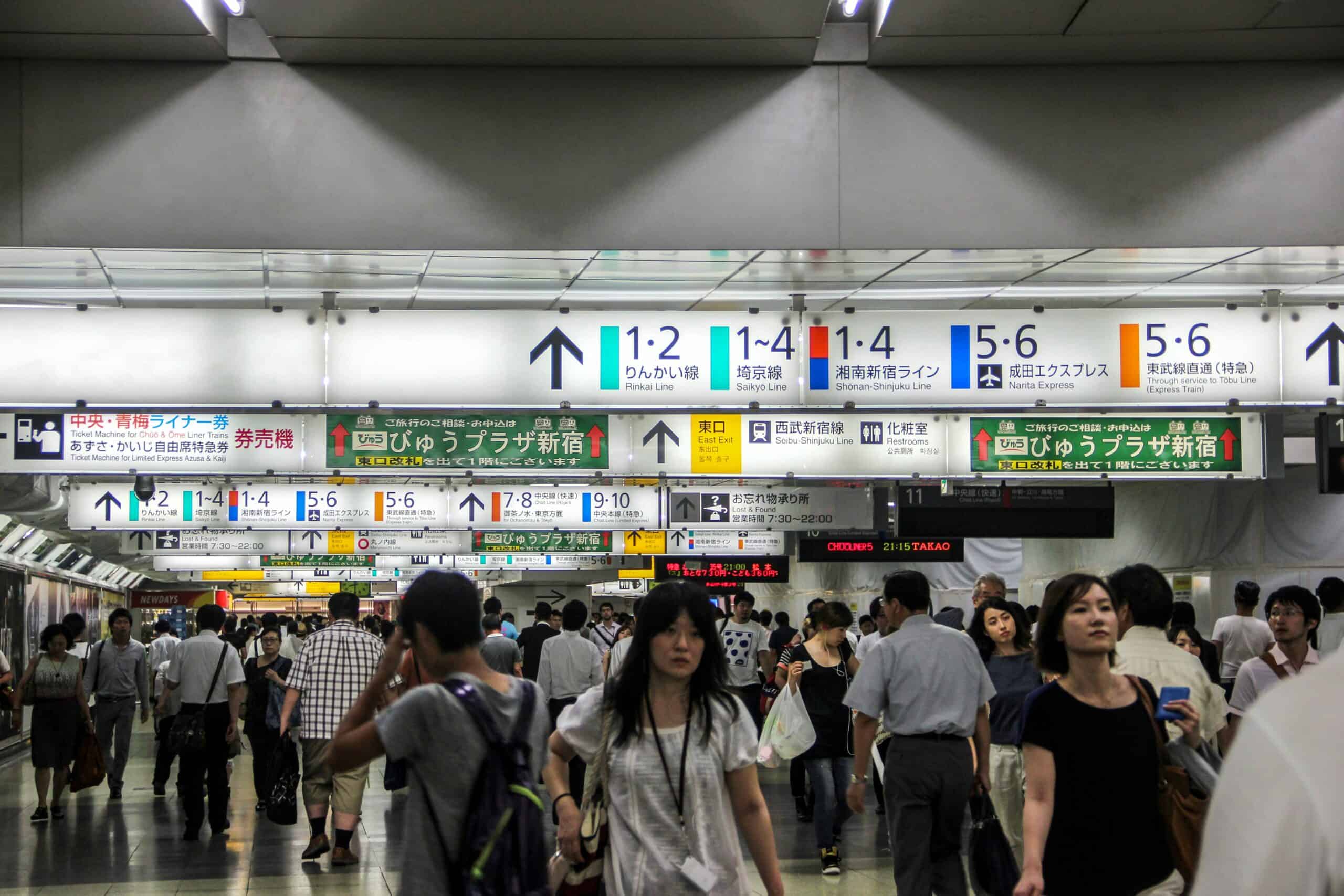
It looks confusing, but the Tokyo metro system is ordered despite its size.
Transport is On Time
Japan is a country of expert timekeeping and Tokyo, despite its frantic city status, still adheres to the rule. I’m a Londoner, and this never happens, so imagine being in a place where if a train is due to arrive at 15.34, it pulls in at 15.34 and 40 seconds and leaves at 15.34.
A local informed me that if a train is late, you can request a ticket from the platform inspector, who will state, by the minute, how long the train was late. You can then present it to your employer. There’s no messing here.
However, it can be a panic when you have to meet a Japanese friend. I was nearly 10 minutes late meeting somebody at a station (to be fair, I got lost), and I felt terrible – tardiness is not respected.
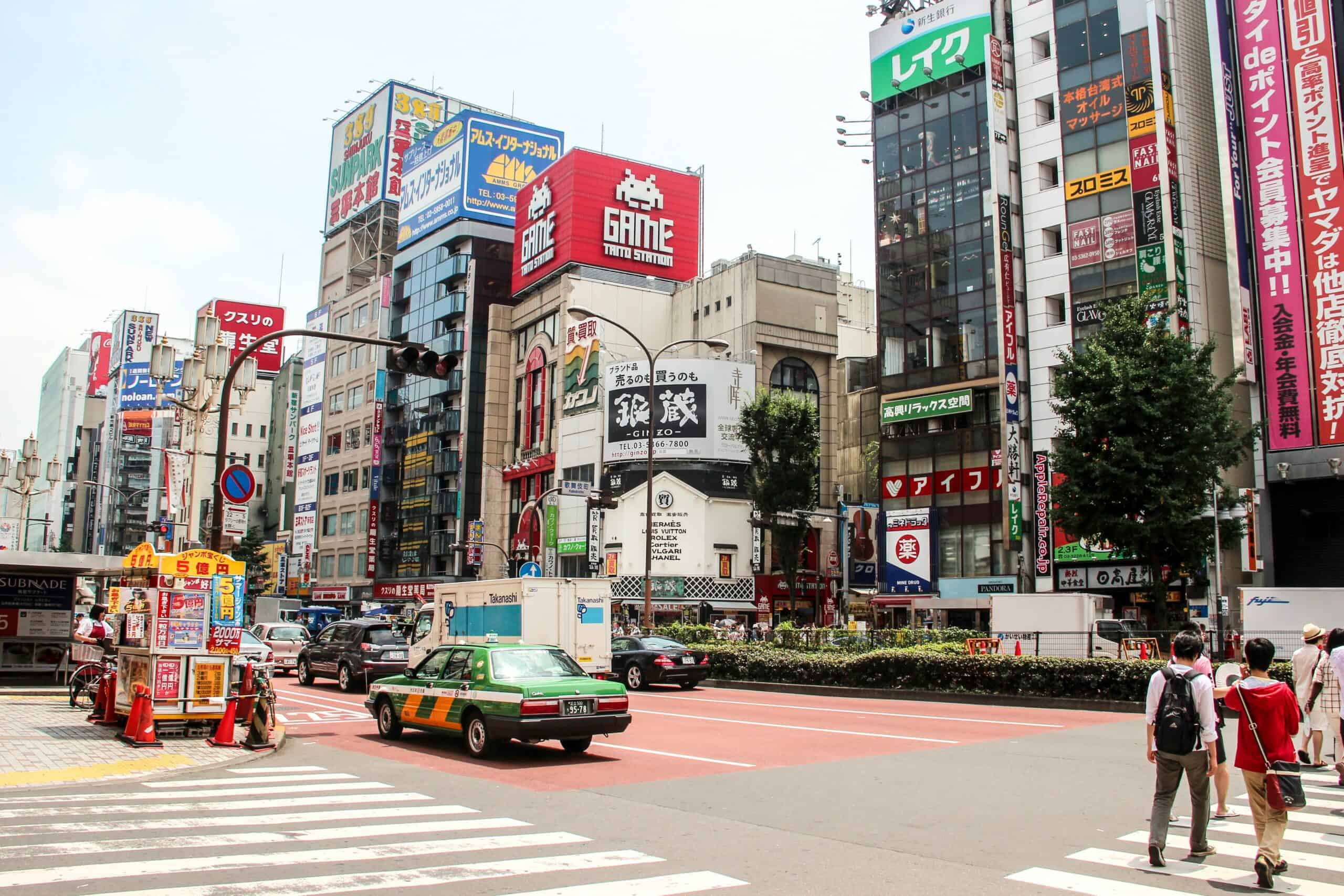
Downtown Tokyo.
Plastic Food Previews
Plastic food in Tokyo (and wider Japan) for a preview is one of the best inventions ever created, especially in a country with a huge language barrier for us visitors. It reminds me of when I was a kid when I used to play with this material that you shaped and put in the oven to harden. If you are not sure what to order or are curious as to what your dish contains, fear not – the plastic food mock-up will show you precisely what you will be purchasing. It looks scarily similar.
Plastic food dishes are placed casually in front of the restaurants or are lined up in the shop windows. There’s even a plastic re-creation of every cake and cookie available in specialist confectionary shops, too. A preview that’s plastic fantastic.
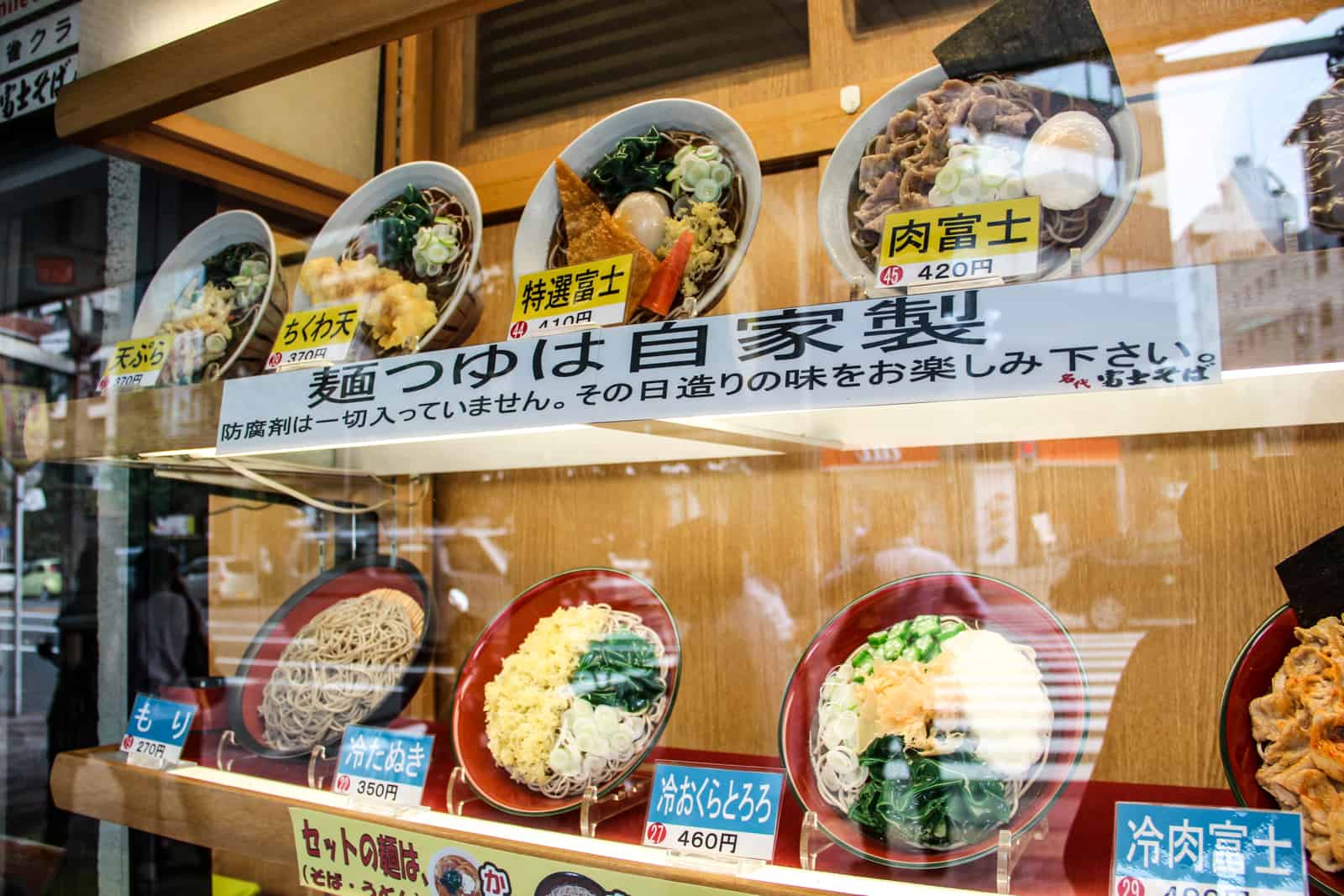
Plastic food on display at Japanese restaurants makes it easy to choose and know the price.
Vending Machines on Every Street Corner
If you were to ask what Japan looks like, vending machines would likely make the description list. The Japanese LOVE vending machines, and you will see them on every street corner, train and bus station and even near shines and public parks. The same goes for Tokyo. Some small restaurants also have a style of vending machine where you select your meal, pay and present your ticket to the waitress, the same with some of the ‘Love Hotels’. It’s all a part of the Japanese attribute of being super organised and time-efficient.
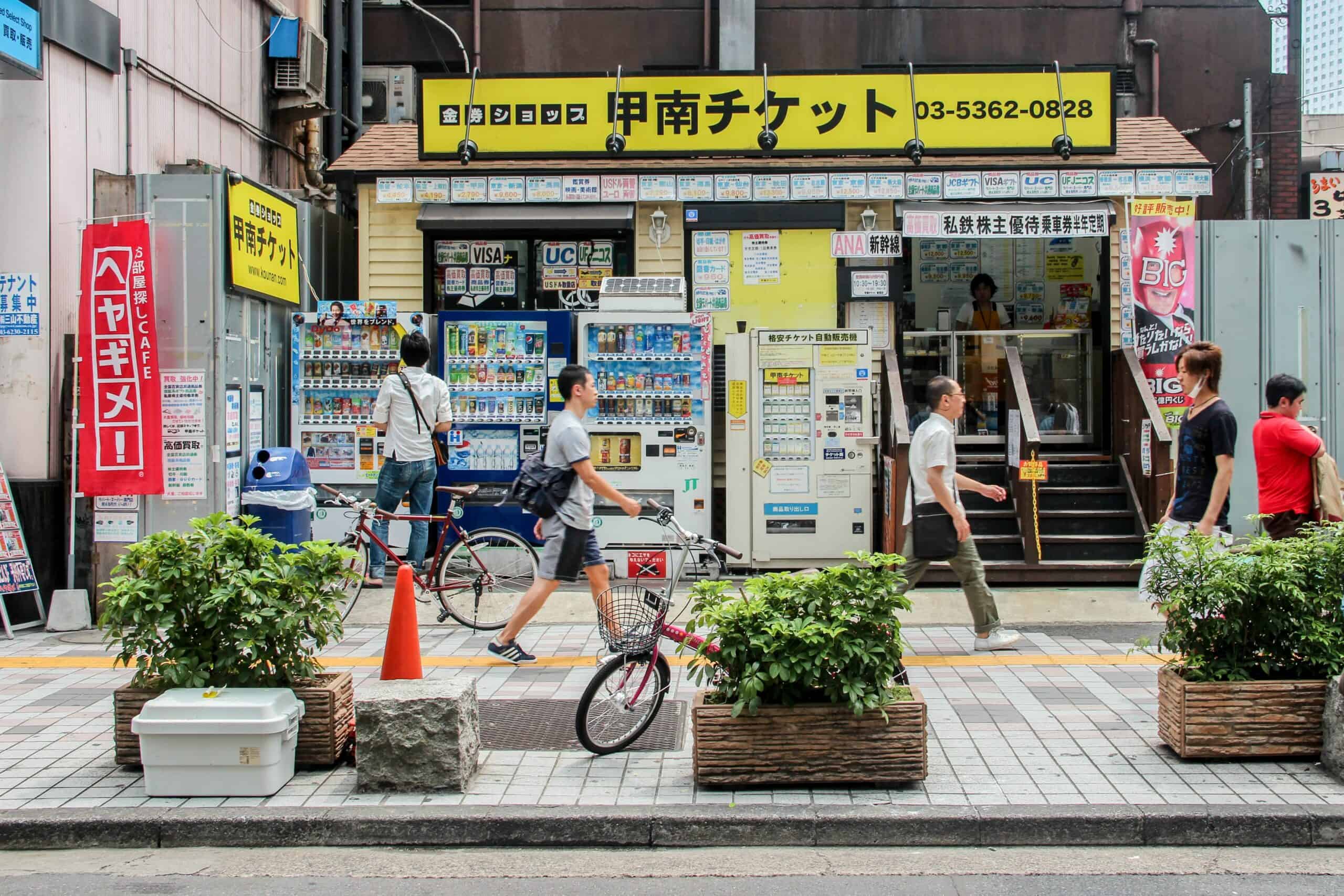
Vending machines can be found all over the streets of Tokyo.
Japanese People are Always Helpful
Even with the extreme language barrier, a local in Tokyo will always try to help you in the best way they can. Every time I asked for directions, the person didn’t just point; they walked me right to the spot – whether that’s the right train platform or a destination that’s a 10-minute walk away. Others happily get out their mobile phones and get technical with GPS.
For a nation of people who strictly adhere to time, they always have time for you. For the kindness of strangers, arigato (thank you), Japan.
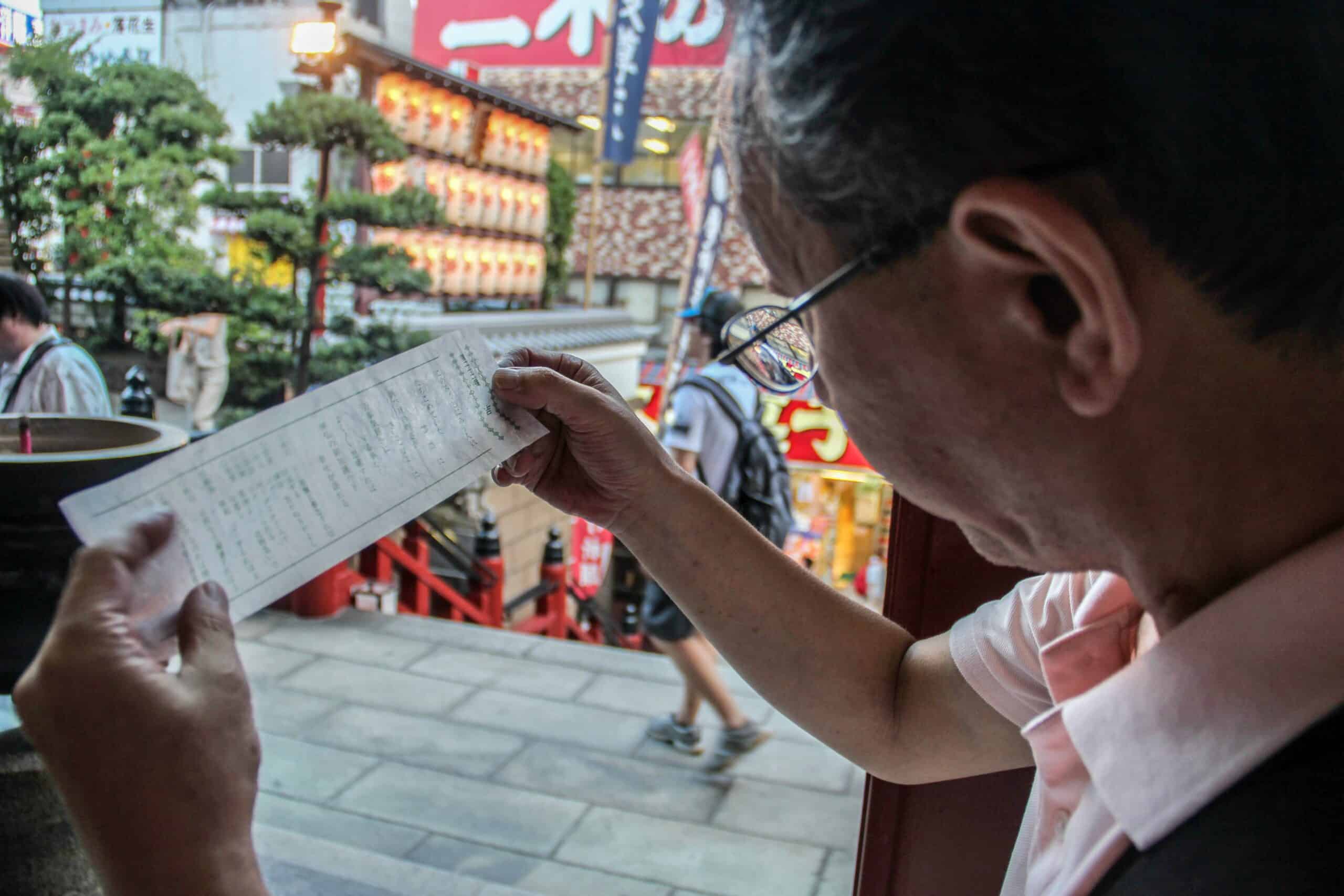
A Japanese man reads my fortune from a temple prayer paper.
Tradition still Exists in Tokyo City
Tokyo might be a modern city, but there are still areas that have kept with traditional designs and layouts. From the Imperial Place grounds in Marunouchi and the Sensō-Ji temple in Asakusa, the charming ‘old atmosphere’ neighbourhoods of Kagurazaka and Ueno, to the restoration and continuation of the Ryokan houses as forms of accommodation, the traditions, architecture and character of aged Japan still poke through Tokyo’s contemporary canvas. This isn’t just another concrete jungle.
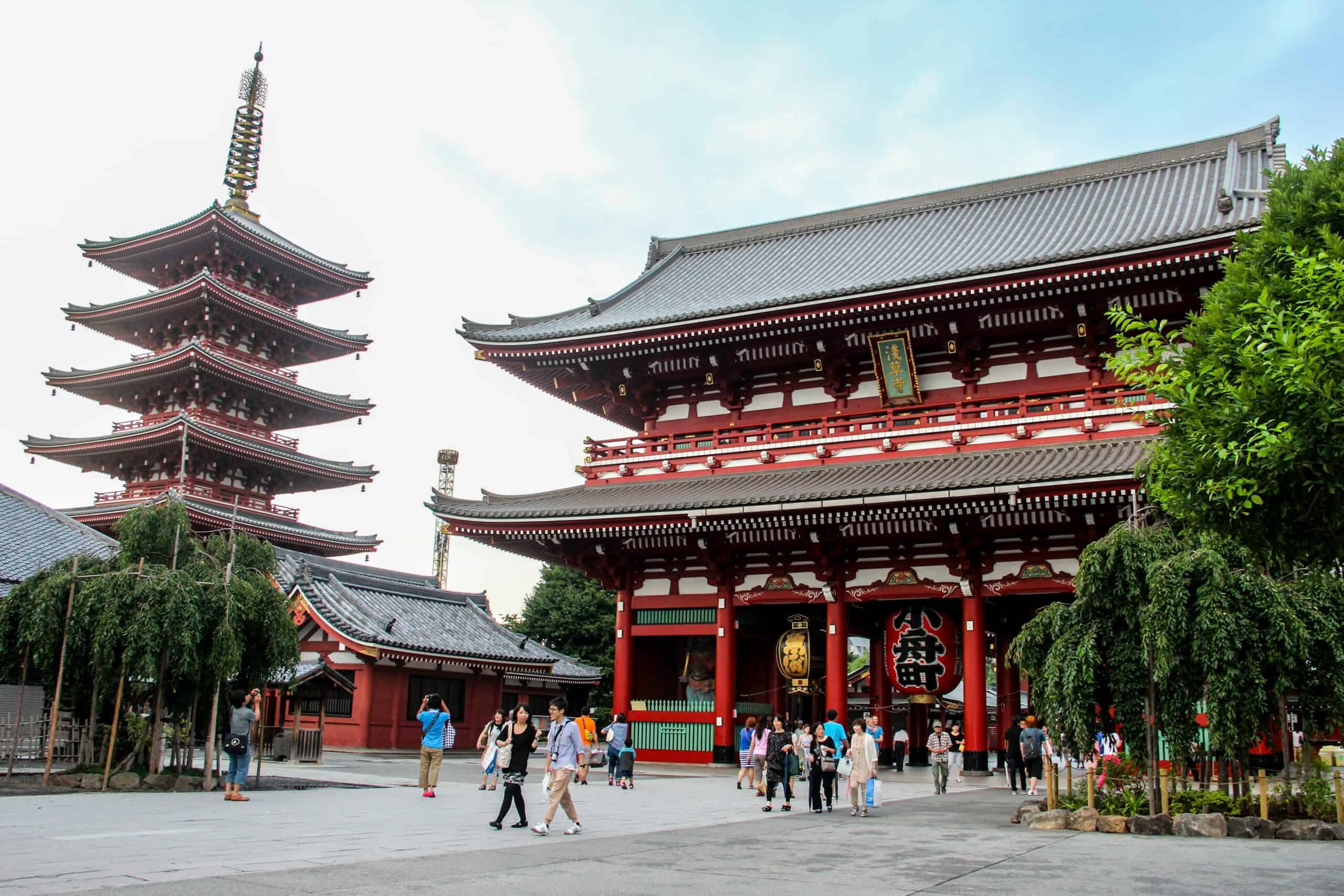
Senso-ji – the oldest temple in Tokyo.
Drink in Tokyo’s Tiny Bars
The Shinjuku Golden Gai of Tokyo is known for its small cosy bars at street level, packed down a compact area of narrow streets. These tiny alleyway bars are often eclectic, loud, filled with junk that could tell a lifetime of stories and are marked by neon lights. Some are even attached to the owner’s house. For a real, local experience, squeeze your way into a bar at Golden Gai and come away with some great stories.
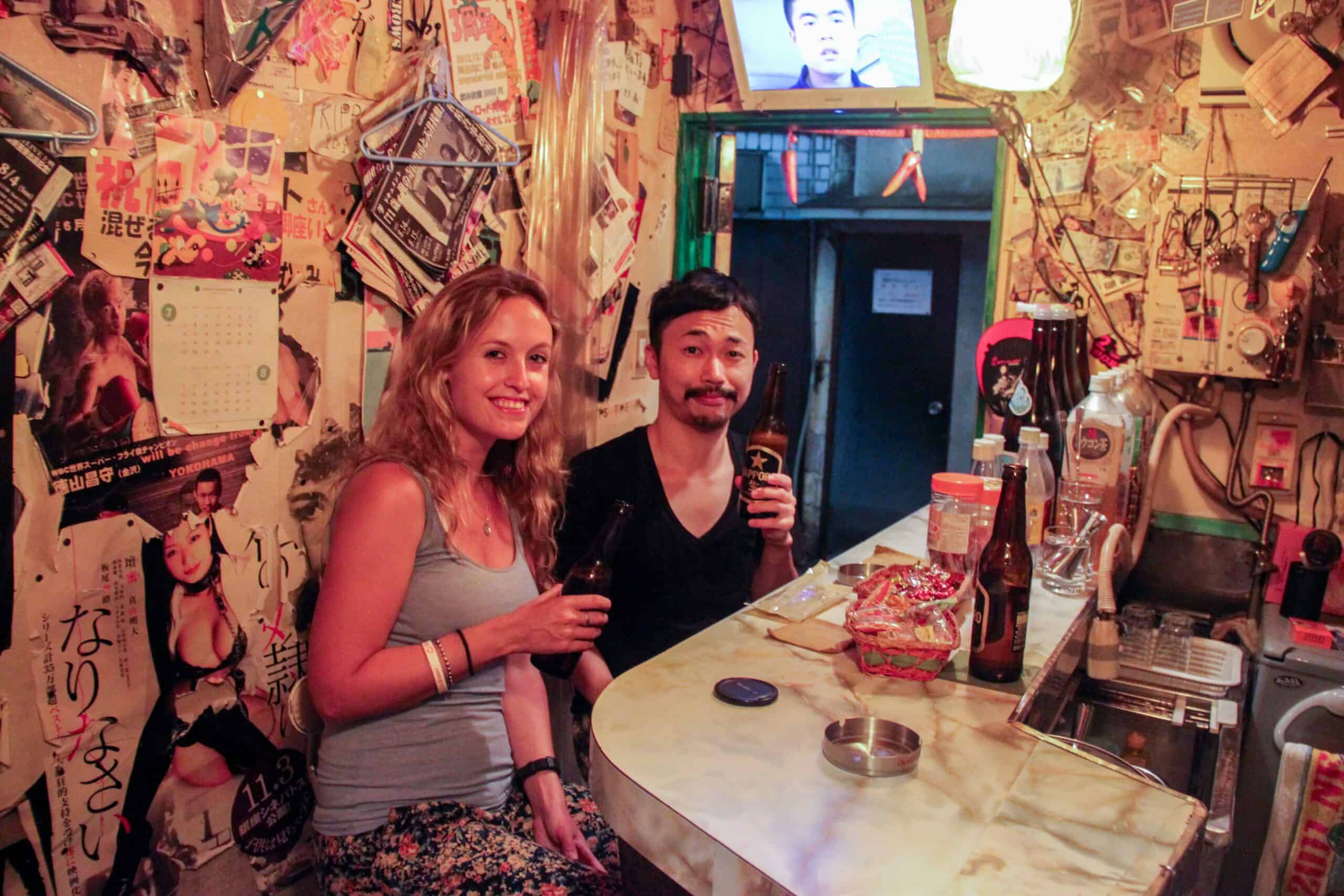
You haven’t seen Tokyo until you’ve had a drink in a tiny bar in Golden Gai.
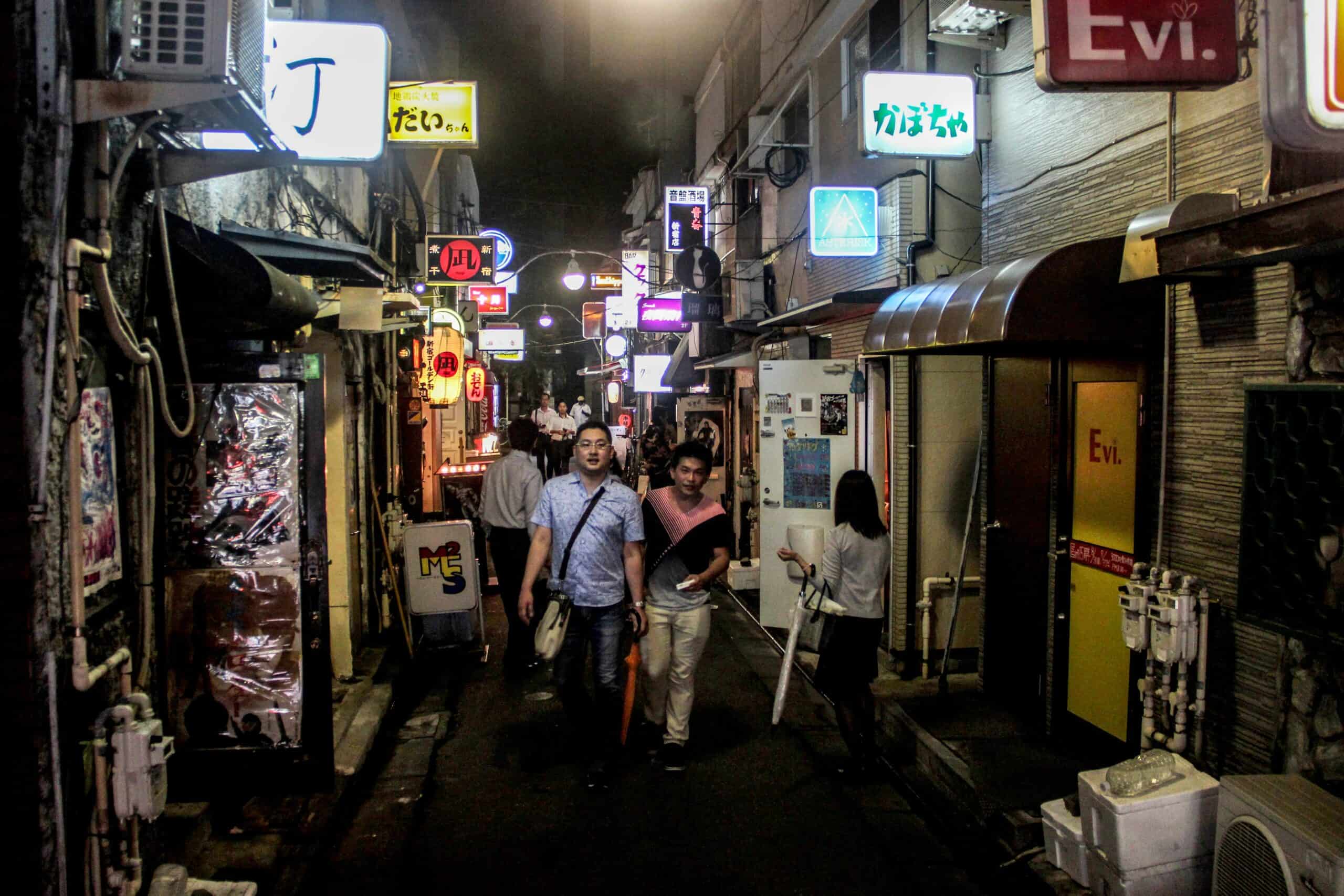
The narrow alleyways of bars in Shinjuku Golden Gai Tokyo.
Dare to Enter Ear-splitting Pachinkos
I’ve lost count of how many of these ground-vibrating, rackety and deafening arcades I walked by or wandered around in fascination. A Pachinko, as it is formally known, refers explicitly to the arcades that contain row upon row of the mechanical ‘slot’ machines unique to Japan. The noise is overwhelming, and you can’t help but stand there and be transfixed. It’s serious business, and the manager who wanders the isles will quickly usher you out for trying to take photos.
A Pachinko forever taints my love of British seaside arcades – which now pale in comparison.
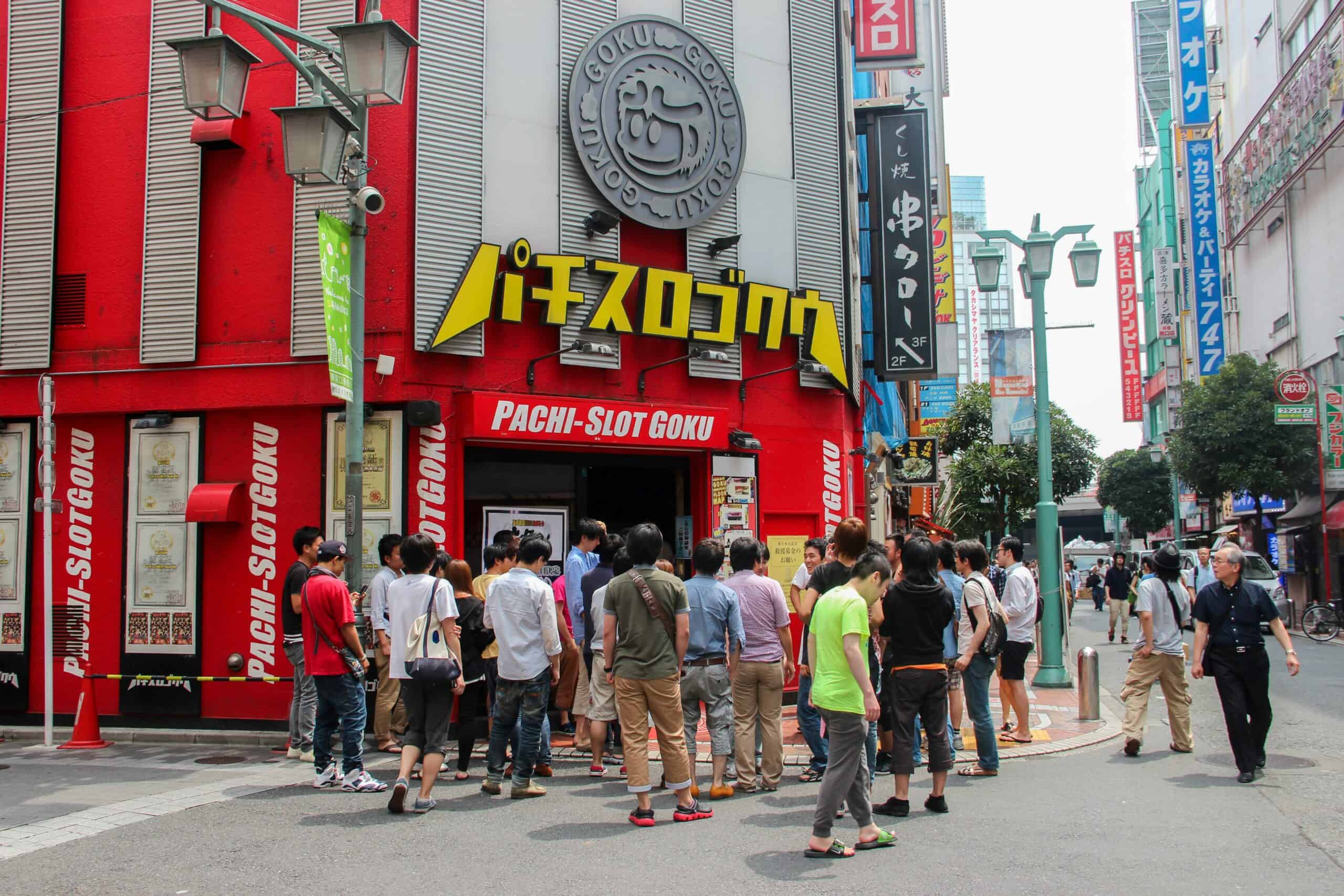
Queues to enter the Pachinko arcade in Tokyo.
There’s a Theme Park in Tokyo’s Centre
There I was, taking a stroll in my quiet neighbourhood in the northeast of Tokyo – close to the Kasuga metro. It’s the kind of place that has tiny restaurant buildings with small doors, a few shops, and a small business district you could easily pass by. Then from a distance, I saw twisting tracks of metal protruding from the top of an office tower, figuring it was a funky piece of architecture in this otherwise nondescript place – a roller coaster in the city.
It was the Tokyo Dome City complex – a stadium coupled with various attractions, rides, shops and food courts – at the end of the road – randomly, in a residential and business area. You have to travel miles for that kind of thing back home! I guess it’s something to do on the way home from work.
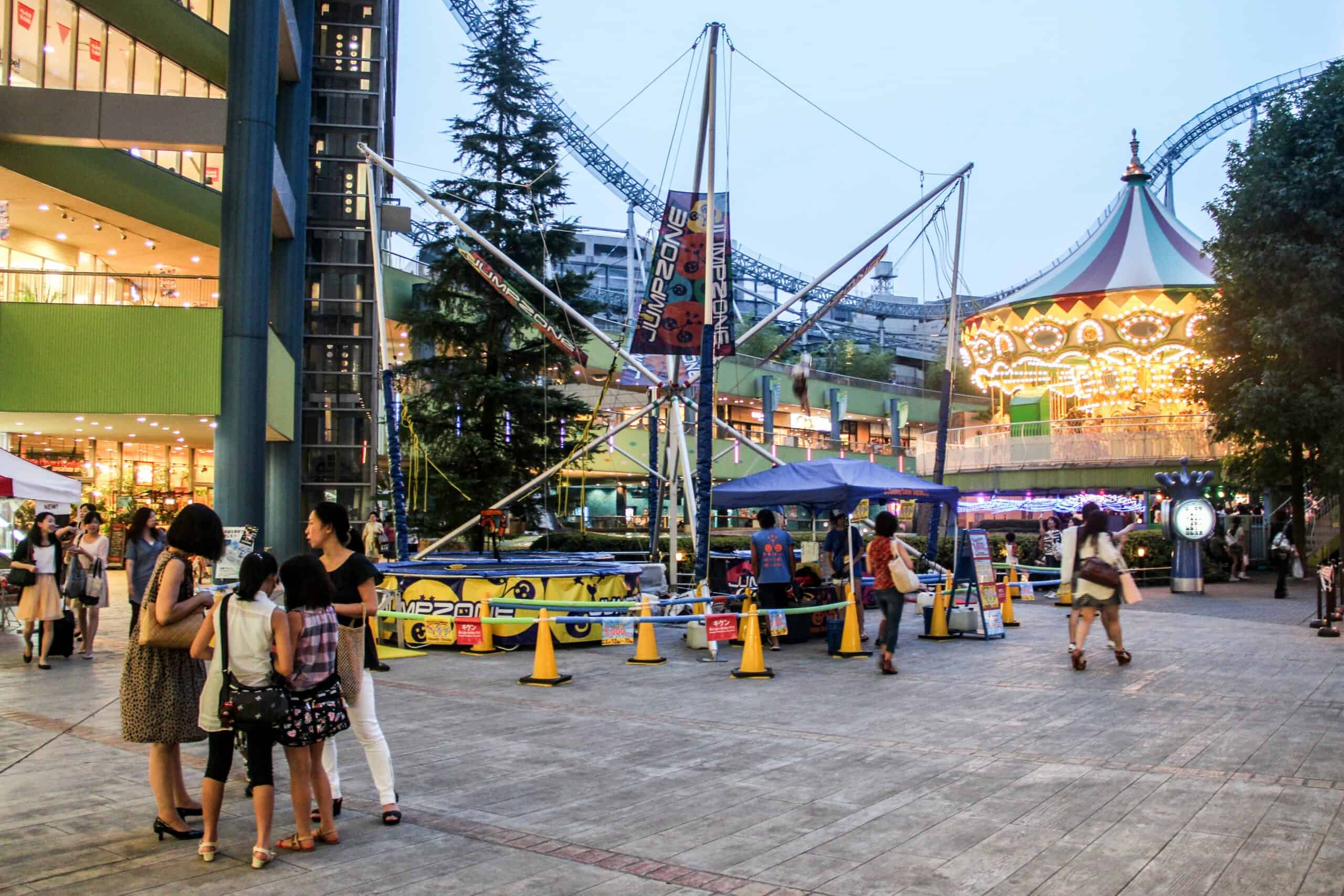
The rollercoaster at Tokyo Dome City.
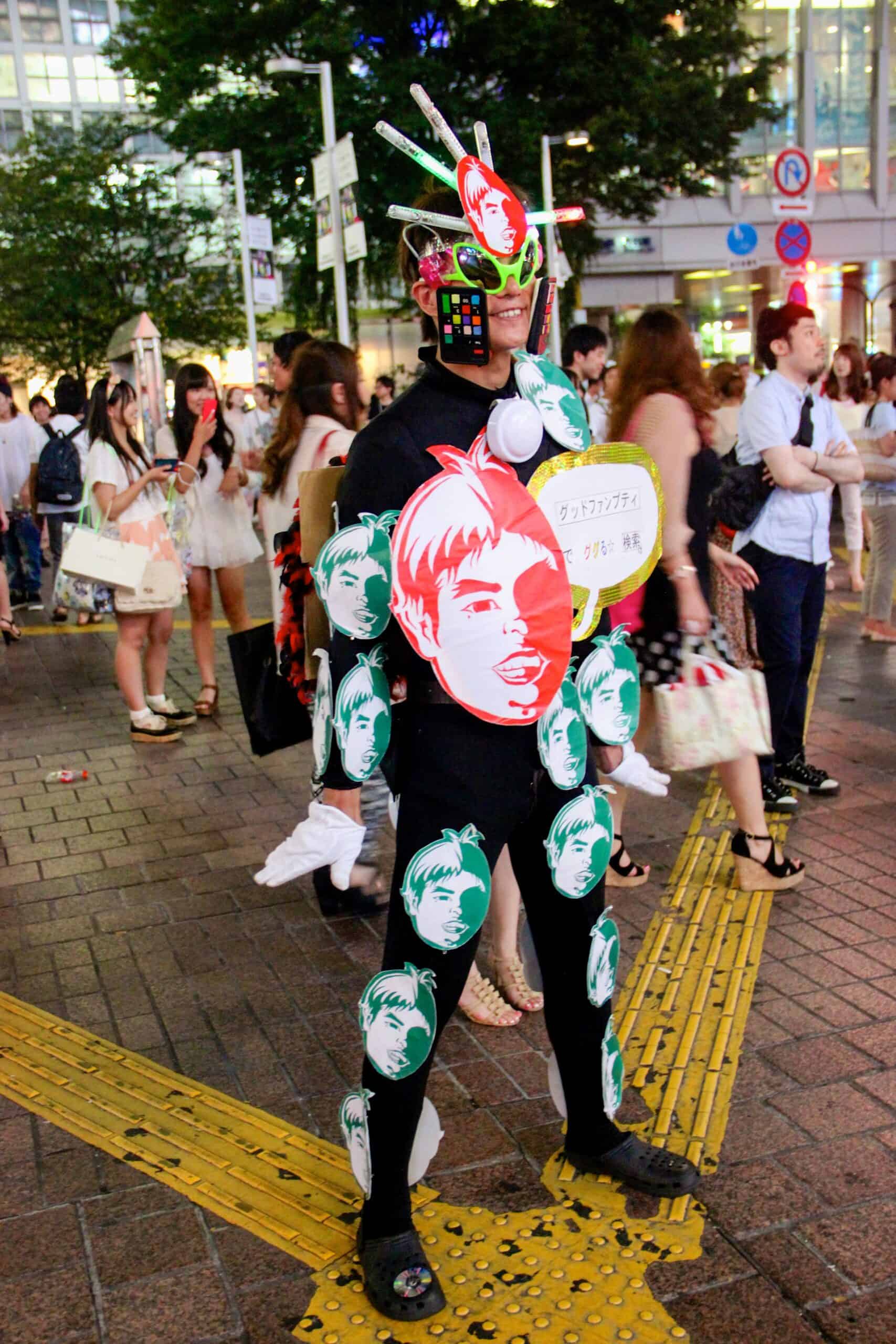
Street performer in Tokyo.
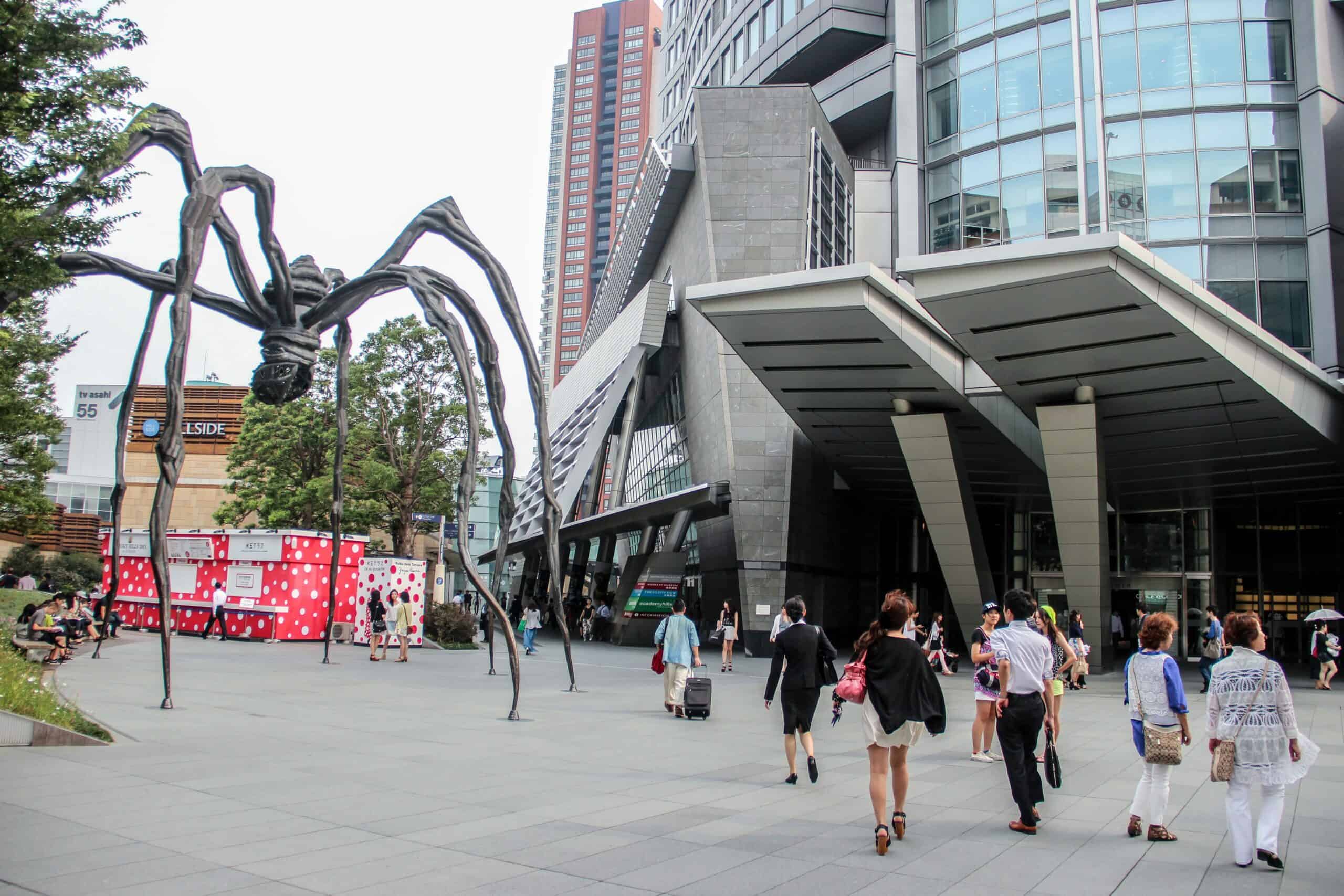
A giant metal outside Tokyo’s Mori Art Museum.
Have you been to Tokyo? What else is there about the city that you think makes it so unique?
Day Tours in Tokyo
Without one Tokyo description to describe it all, it’s a city best experienced in a multitude of ways. From architecture walks and food indulgence to cultural experiences and city views, there are plenty of ways to see Tokyo and get under the surface of its kaleidoscope of personas.
View and book attractions and activities in Tokyo.
Guide Books and Further Reading
- I travelled with a Japan Lonely Planet, which I found particularly useful when needing to show Japanese text for name places and other destinations. The updated version was released in August 2019. The National Geographic Traveler guide book to Japan is also a beautiful insight into the main cities, towns and regions from the revered travel platform.
- If you are fascinated by the nuances of the culture here, the Etiquette Guide to Japan book is a fascinating look at Japanese social rules and graces.

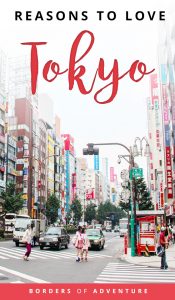

Roshan Kumar says
wow, such an interesting post. In a very nice way you have described the top most famous things of Japan.
Marcus says
Wow this was a great post and i loved the pictures! I’m going to college in Michigan for 2 years and for the last two years I want to go to Tokyo International University and live there for a little bit! I always try to find good feedback from other people who went to Tokyo but a lot of them were always negative feedbacks 🙁 but thank you very much! I enjoyed every bit of your adventure 🙂
Shogo says
Hi Becki, how difficult was it to get around as a non native speaker? Also did you get a chance to visit Yamagata? I’m from the U.S. but my father is japanese and I have family in yamagata who are farmers but don’t speak japanese fluently.
Becki says
It can be tricky but my tips are. 1. Take a guide such a Lonely Planet that has Japanese characters and words 2. Find the younger generation to ask for help as they are more likely to speak English. All in all though, with the Japanese being as super helpful and kind as they are, there is always a way around a problem. Someone will always help! I didn’t go to Yamagata. I hope to visit Japan many more times… it’s too incredible to only go once.
Luke says
In regards to the vending machines, I read somewhere that Japan has been trialing vending machines that accept empty plastic bottles as payment or partial payment to encourage people to recycle.
Shannon says
They have a similar system in Germany with bottles 🙂 If you return a bottle while buying a new one they give you a discount. Its a very good system actually, I don’t know why other countries haven’t taken it up yet.
Steffen and Anna says
Oi Becki!
Stumbled upon this site and recognised you from the snorkelling trip on the Perhentians last March.
You were with your Finnish-Vietnamese friend and we had lunch in that main village/town of the island. 🙂
We’re planning a trip to Japan, if only in a year’s time next autumn, since Russia will be our next destination in spring, but I learned a lot about this country already!
Anyway, great and entertaining site, trying to suck up all your other travel reports, too 🙂
Becki says
Hey there! Yes, I remember you, although my days on the Perhentians seem so long ago now! Glad you stumbled upon it and I’m very happy to hear that you are off to Japan!! Thanks for your kind words, and hopefully will bump into you on the road again someday 🙂
Christoffer Moen says
Leave a wallet, umbrella or any of your possessions anywhere and when you come back your almost always going to get it back. I love their honesty. And something about passed-out salarymen dozing peacefully wherever they damn want to pass out is strangely endearing something done elsewhere would have made me shake my head. Man, I miss Japan already.
Becki says
I love the honesty here. I saw a businessman leave his bag on the train whilst he popped off the train to grab a drink. That would NEVER happen at home!
Kellie @ The Fundamental Alchemist says
I’m glad you’re enjoying your time here! I live in Okazaki but I was in Tokyo for a few days last week. It was my third visit but I feel like it’s taken me a while to get to grips with the place. I’m going back next month for more.
Looks like you’re seeing a lot of the best bits. I recommend going to Nara if you can :o)
Elle Williams says
Japan never really appealed to me when I was younger, but as I get older the country has really gone up in my expectations – especially the cultural side of things and the beautiful buildings. It’s a photographers dream! Thanks for writing such a lovely post! x
Becki says
It only appealed to me when i was younger because of the Memoirs of a Geisha book and film and I also grew into a city loving girl – so the Tokyo-Kyoto-Osaka route is perfect. It’s a fantastic place to visit and is really everything you imagine it to be!
Rashaad says
Did you play any pachinko in Japan? I never played any pachinko over there – probably because I was so scared of losing…
Carl says
Great article Becki! I was there in March and couldn’t agree more with every single aspect you pointed out.
Oh actually there was one I didn’t get to see – I never had time to experience a crazily themed cafe like that one! So that’s on the list for next time. I did manage to go to an awesomely chilled – and surprisingly swanky – cat cafe though at least.
Carl says
It was Calaugh Cat Cafe in Asakusa that I went to. Probably a minute – if that – from the capsule hotel you stayed in there. It’s just across the road from Burger King, and a couple of floors up one of the buildings. I was expecting some crazy cat den, but it was actually a really stylish coffee lounge – just with the awesome addition of cats!
K says
My boyfriend and I are saving for travelling at the moment, he really wants to go to Japan but it seems a lot more expensive than the rest of South East Asia. Did you end up spending a lot in your week? Are the guesthouses/hostels really expensive?
Becki says
I have spent more here than any other country in Asia. Dorms and private rooms are around $20 upwards per night, food is around $7 upwards for a dish (although super cheap sushi can be found). My three week JR Rail pass was $600 approx (and sometimes you have to use a non-JR Rail line so that’s extra travel costs on top). It’s worth it as it is an incredible country, just don’t expect to live on $15 a day like you can in some South East Asian countries like Cambodia and Laos.
Tammy says
Those themed cafes sound great. I like the sound of a Ninja themed cafe. Question is, do they sell absinthe or tequila? 😉
OCDemon says
I noticed the signage density in a lot of places. I think it’s partly because the shops are small so there are 10 times as many per street, but still, I think they have more signs per shop than most other places ever would. Maybe it makes them better readers.
Becki says
Small with many floors! They certainly know how to maximise space, especially when it comes to business. I love the signage, everywhere I go.
Nimish says
I had been to Tokyo last year and I could relate to a lot of points you raised above, specially about tradition and the helpful people and of course the mad fashion at Harajuku. One experience that really sticks out from my Tokyo trip was the serendipitious discovery of the Yakotori alley near Shinjuku metro station. I found a bit of Old Japan there with the cheek-by-jowl eating joints, no plastic food outside the eateries, no one who could speak in English. I felt like a little kid and selected what I was going to eat by just pointing to a picture of the food I thought I would like.
I think for my entire stay in Tokyo, there wasn’t an hour that passed by where I wasn’t exposed to something new or learned something new. I hope i am back there sometime in the near future.
PS: Btw that anecdote about employees getting the platform inspectors to state by how many minutes the train was late was quite fascinating.
Beth says
I’ll admit, at first I hated Tokyo. I always preferred Osaka and Kyoto because that was where I lived in Japan. But after giving Tokyo a second chance, I’ve fallen in love. I really hope I find myself back there soon!
Becki says
I can see how it would put some people off – it’s a complete culture shock in parts. I’m completely in love with Kyoto and would live here, but Tokyo is it’s own unique breed of city!
Arianwen says
Wow! Those shops are crazy! And I love the interesting outfits. I’d enjoy Japan too. I like to visit places where everywhere you look is something different from what I’m used to.
Angela says
Tokyo has been on my to- visit-list since forever. Every time I see or read something about that city I fall in love even more.
Gino says
I’m the same way lol. Everytime I read about Tokyo I fall in love with the city more. Man I’ve always wanted to visit Japan for ages now. Im 30 and never been overseas yet lol. I’m really big into The Japanese Anime especially Dragon Ball Z and I heard a lot of people are very friendly and polite there. This is my #1 top place I wanna visit in my lifetime. 🙂
Matt Brown says
Thanks for this, it brought back good memories, and showed some new things I missed. I also felt that Japan was a window into the future in a lot of ways, and its peculiarities charming – wet hand towels before every meal, heated toilet seats!, taxi doors that close by themselves, (most) people waiting for green traffic lights before crossing the road even when there’s not a car in sight, the lovely temples and gardens… Hope to go back some day!
Becki says
I love hearing other peoples’ loves. The first time I saw a taxi door open on its own I was in such awe. The Japanese really are the window of the future – it’s incredible. I also love the bowing and little head nods. I adore politeness.
Matt Brown says
Agreed. When I first arrived I got the coach from the airport to the city. The girl manning (?) the bus stop bowed at the coach when it arrived, and also when we drove away. Love it.
Lunaguava says
The mix of ancient and futuristic did it for me, plus every single thing you mention. I must say I loved the vending machines – visited in January, and often traveled very early in the morning, so used to grab a warm bottled ice tea on my way to the next temple or train. A little detail, but it just made everything seem… nicer. Oh, and the fact every little train or subway station seems to have lockers available. And clean toilets! And the mountains are really close and fantastic for a day trip or more. And… and… and.. OK, I really miss Japan. Thank you for the nostalgia trip!
Becki says
Tough as so many things are Japan specific and not just Tokyo so I left them out. Nostalgia indeed. I am heading back to Tokyo ago to get a fix before I leave!
Amanda says
I had a friend study in Tokyo, but she is not very much a city person. I would love to visit! Those store pictures are astounding, I can’t even imagine that! One thing I would love to see is the polite nature of everything. Was it culture shocking at all? Coming from Philadelphia, it’s probably a total 180!
Becki says
Take the opportunity to visit there while a friend is there! There is a certain element of culture shock for sure – mainly with the extreme language barrier. But it’s more fascination and wonder rather than the feeling that’s its too difficult. Sometimes you feel lonely and ‘lost’ in that lost in translation sense, but that depends on the individual person how they handle that.
Jennifer says
Hello Kitty didn’t make the list? 😉 Seriously though, Tokyo sounds wonderful! Absolutely love that photo above #15.
Becki says
I know, I know. I feel ashamed. It was tough you know…some things are Japan specific and I could have added them…but the list would go on and go.
Beverley says
I’ve never been to Tokyo but I’d absolutely love to go! I love the cities quirks and how friendly everyone seems – definitely adding this to my list 🙂
norm says
What a great place, and I cant get over the cleanliness and sparkling vitality to the place, yet there are spots with greenery, lakes and beautiful trees to reflect and relax. Did you ride the bullet train, what was that like?
Becki says
The bullet train is a rite of traveller passage in Japan. It is fun!